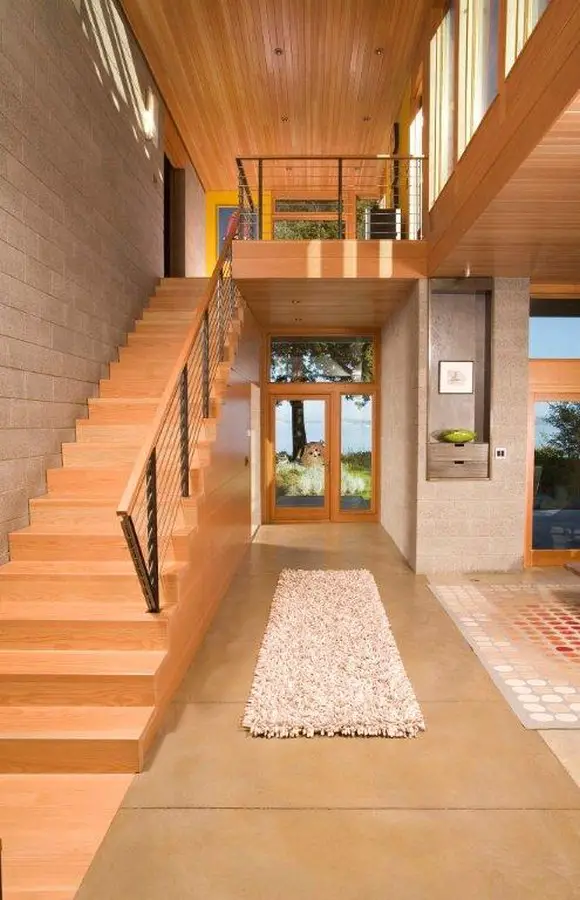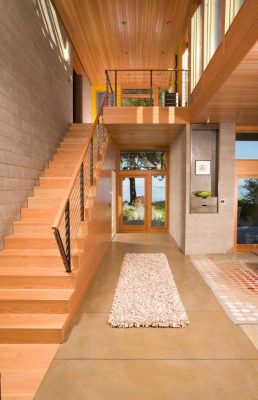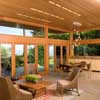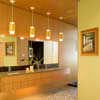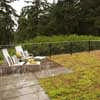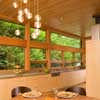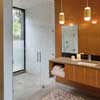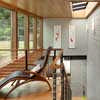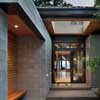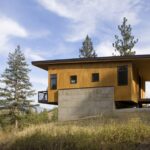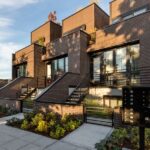Seattle House, Yeomalt Bluff Home, Puget Sound Residence, Bainbridge Island Property
Ellis Residence : Yeomalt Bluff House
New Washington Home, USA: Puget Sound Home design by Coates Design Architects
Oct 19, 2011
Ellis Residence at Yeomalt Bluff
Location: Yeomalt Bluff, Seattle, Washington, USA
Architect: Coates Design
Yeomalt Bluff Residence
The Ellis Residence is an example of modern residential design incorporating local environmental concerns, state-of-the art energy efficiency and visionary educational opportunities for the public. The project embodies the client’s vision of home that raises the bar for energy producing housing while maintaining aesthetics and livability. This LEED Platinum certified home is a milestone in the efforts to create truly sustainable designs.
Perched high upon Yeomalt Bluff, this home enjoys a commanding 180 degree view of the Puget Sound and City of Seattle. It features a 70% energy use reduction compared to an average North American home through the use of geothermal heat, photovoltaic energy collection, solar hot water, thermal massing, and heat-recovery technologies. Additional key features include: rain water collection cisterns, radiant floor heating, site-milled wood trim, triple-glazed windows and a vegetated roof.
SOCIAL FACET
A key goal of the project was community outreach and education. Owners Ed and Joanne Ellis wanted to prove that sustainability can be achieved without compromising a modern aesthetic design and they wanted to motivate others to follow suit.
The Ellis’ are proud that their home is the first LEED Platinum residence outside the City of Seattle. The single family residence houses two bedrooms and many flexible living spaces combining many functions such as living, dining, office, and media spaces. The design limits its impact on the environment with a multitude of sustainable practices.
AN ENVIRONMENTAL ETHIC – ELEGANTLY EXECUTED
“It’s the joy of being in a space that is me. That’s what a custom home should be. It should fit you like a fine tailored suit.” —-Joanne Ellis. What stands out about the residence is that it is cool and contemporary plus elegant and comfortable.
It doesn’t flaunt its sustainability – but for the record, it is the first LEED Platinum residence outside of Seattle. Coates Design architects created a perfect blend of modern aesthetic and sustainable lifestyle. “We don’t have to compromise here, “Ellis says. “We live in luxury.”
TECHNOLOGICAL FACET / Unique or special materials used:
The use of local materials, native vegetative roof systems, rain water gardens and permeable paving the building works in synergy with the landscapes natural systems. An innovative hybrid insulation system of closed-cell spray foam and batt insulation was used to provide maximum insulation performance and air-tight construction at an affordable cost.
In addition, triple-glazed wood windows were installed throughout the project. Untreated FSC certified hardwood “rain screen” siding assembly provides a low maintenance, moisture resistant cladding system. In addition to the hardwood siding, recyclable metal panels and CMU block comprise the remainder of the durable exterior envelope.
Unusual or Creative Architectural Design Elements:
Overlapping programmatic use was a key goal. Creating space that has multiple functions means an overall smaller footprint. That is why you will find the laundry appliances and clothing storage built into the master bathroom casework, and an office within the corner of the media room, or sliding and bi-folding doors that transform smaller spaces into larger gathering spaces that can be easily connected to the outdoors. Even more so, the home’s roof becomes a vegetated garden patio – the ultimate get-away.
ENVIRONMENTAL FACET / Creative Site Solutions:
The project’s ecologically small footprint was not just constrained to the construction of the new house. The site had an existing structure on it that the team deconstructed, effectively diverting 98% of its material from the landfill.
Before construction began, subcontractors created detailed lists of FSC certified framing and sheathing to more accurately place their lumber orders to reduce waste. Additionally, the contractor tracked all waste and recyclable material on the site to provide a 75% landfill diversion rate. Interior trim and stair material originated from site-milled fir trees that were fallen from a neighbor’s property.
Much of the existing site was covered in turf and impervious paving. The site was rehabilitated with native and drought tolerant vegetation and pervious pavers. The crest of the bluff was restored with plantings to reestablish habitat and to prevent erosion. Extreme care was taken to preserve natural habitat and existing trees throughout the construction process.
A large rain-garden is integrated into the west side of the site, providing an on-site eco-system and habitat as well as collecting and filtering storm water runoff. Care was taken during construction to reduce, contain, and treat any runoff pollution. The construction area was limited and filter fabric fence encircled the construction area. Also, a wheel washing station was provided for all vehicles leaving the site.
ECONOMIC / PRODUCTIVITY FACET – also Facts or Features to Enhance the Exterior/Interior Appeal
The unique site provides panoramic views over the Puget Sound: from Mount Rainier to Mount Baker with Seattle as the focal point. The site also overlooks the shipping channels evoking memories of the owners many years of service in the shipping industry. Every room in the house has a unique view to this setting or to gardens surrounding the home. Window fenestrations play a critical role in passively heating the house.
South facing windows along with overhead skylights warm thermal mass walls and floors affectively warming the house even on a cold winter day. In addition to day lighting and views, the operable windows and skylights accompanied by the heat recovery ventilation system, provide fresh clean air in all rooms. The operable skylights also provide efficient natural ventilation through the two-story core at the center of the house. Large bi-fold doors allow the living and dining rooms to seamlessly open up to the exterior terrace.
A large east-west CMU “spine” forms a central thermal mass core for the house. This massive wall reduces temperature swings and is oriented in conjunction with operable skylights to take advantage of cooling techniques. In addition, this wall sets up a division between private and public spaces. To the north, the private portion of the house is much more enclosed for climatic and privacy reasons with very specific views to the exterior.
To the south, the glassy public spaces have abundant natural light and views. To the east, the water side of the house, windows and doors open to allow the naturally cool breezes from the sound to temper the interior spaces. A section cut through the building shows a two-story volume to setup a sense of entry but more importantly to create a stack effect for the building to naturally ventilate during the summer months and passively heat during the winter months.
Two major challenges arose during the design phase of the project: How to obtain efficient, clean energy production in a rainy marine climate on a small forested lot and how to minimize the buildings impact on the site. The final solution for the homes clean energy production was the use of solar collectors and geothermal collectors that worked in synergy to ensure continuous clean energy production for the home.
The second challenge resulted in the deconstruction of only one fir tree on the site by a local arborist. The tree was site milled and integrated into the stairs, benches, and trim throughout the home.
Outside of the intricate, internal systems, the Ellis home looks the part of the greenest home on the island and illustrates the contemporary, modern architecture that the homeowners desired. Naturally-protected ipe wood siding covers the exterior of the home, requiring less labor at installation, producing less off-gasing during construction, and requiring less maintenance throughout the life of the project. In addition, the home is wrapped with native, sustainable landscaping.
Overall, the Ellis Residence is a high performance building that maintains it functionality, livability and aesthetics. The home serves as a model and educational tool for future sustainable residential projects. The project was conceived with durability, aging in place, and recyclability in mind.
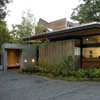
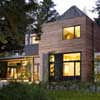
photos : Roger Turk Northlight Photography
Ellis Residence, Bainbridge Island Residence images / information from Coates Design, Architects
Location: Bainbridge Island, Seattle, Washington, USA
Washington Architecture
Seattle Architecture Designs – chronological list
US Architecture Designs – chronological list
Washington Houses
Lobster Boat House
Design: chadbourne + doss architects
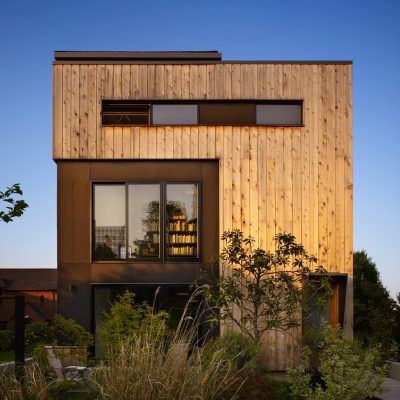
photo : Benjamin Benschneider
Lobster Boat House in Seattle
Mercer Island House, King County
COOP15 Architects
Mercer Island House
Cedar Park House, Seattle
Peter Cohan, Architect
Cedar Park House Seattle
Seattle Buildings – Selection
St Ignatius Church
Design: Steven Holl Architects
St Ignatius Chapel
Seattle Public Library
Rem Koolhaas Architect / OMA
Seattle Library Building
Wing Luke Asian Museum
Olson Sundberg Kundig Allen Architects
Wing Luke Asian Museum building
Seattle Civic Square buildings by Foster + Partners
Comments / photos for the Ellis Residence – Yeomalt Bluff Home page welcome

